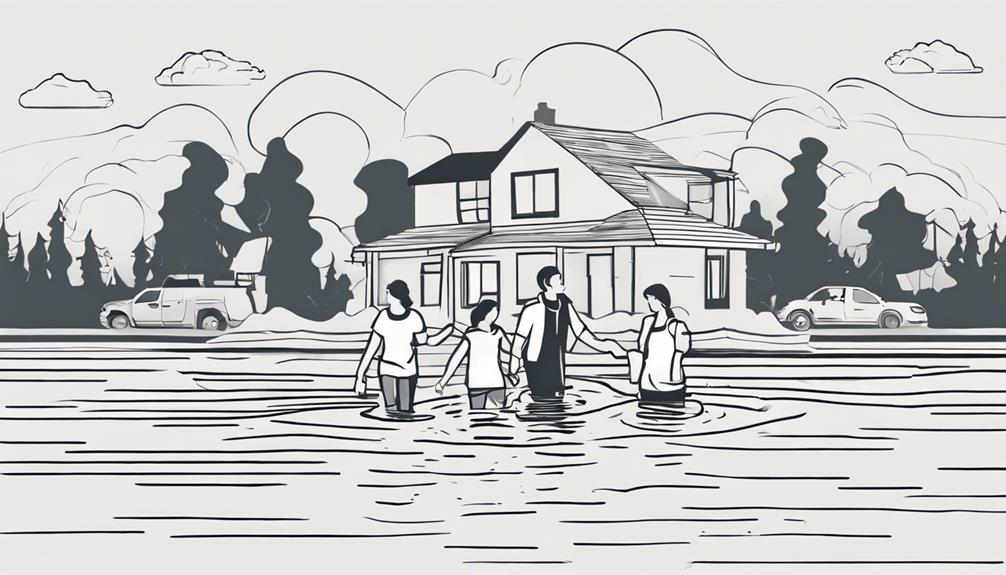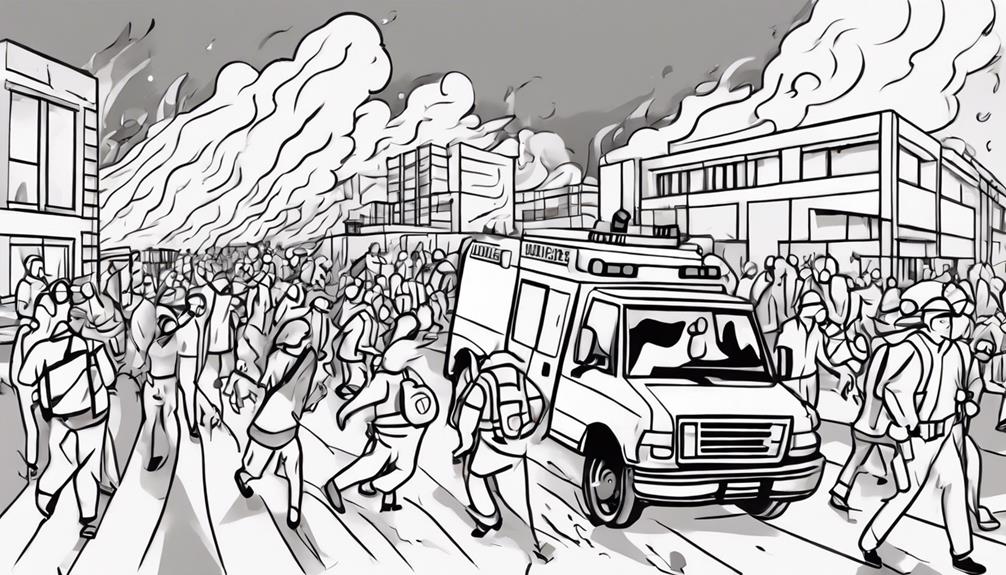Evacuating during a disaster is often met with hesitation or reluctance, as individuals may question the necessity of leaving their homes or communities behind. However, a closer examination of the data and scientific evidence reveals the critical importance of adhering to evacuation orders. By understanding the underlying reasons and principles behind evacuation protocols, we can better comprehend the significant impact timely evacuations have on both individual safety and overall disaster response strategies. The rationale behind evacuation directives goes beyond mere precautionary measures; it is a calculated approach rooted in empirical findings that can make a substantial difference in the face of impending calamities.
Key Takeaways
- Timely evacuations save lives and property by removing individuals from imminent danger.
- Evacuation orders reduce the risk of injuries and fatalities, aiding emergency responders effectively.
- Evacuation minimizes risks, preventing injuries, and safeguarding critical infrastructure.
- Evacuation is critical for community resilience, ensuring quick, safe, and efficient movement to safer locations.
Importance of Timely Evacuations

The critical significance of timely evacuations lies in their potential to safeguard lives and property by preemptively removing individuals from imminent danger before a disaster event occurs. Evacuation plans are essential in ensuring that individuals can evacuate quickly and efficiently when faced with an impending disaster. Emergency management authorities stress the need for individuals to have a clear evacuation plan in place to protect themselves and their families. Making sure to evacuate early can significantly reduce the risk of being caught in traffic congestion, which could impede the evacuation process and endanger lives. Moreover, early evacuations provide emergency responders with the necessary time to assist those in need and manage the disaster effectively. By leaving promptly, individuals can also protect their homes and belongings from extensive damage. It is crucial to have a full gas tank and necessary supplies ready to facilitate a quick evacuation when the need arises.
Safety Benefits of Evacuation Orders
In light of the demonstrated effectiveness of timely evacuations in mitigating disaster risks, a critical examination of the safety benefits associated with evacuation orders becomes paramount. Evacuation orders play a crucial role in reducing the risk of injuries and fatalities by ensuring that individuals are moved to safer locations away from immediate threats. Compliance with these orders not only safeguards individuals but also allows emergency responders to focus on saving lives and providing assistance effectively. By following evacuation orders, people can avoid being trapped or isolated in dangerous situations, thus significantly enhancing their chances of survival during disasters. Moreover, evacuation compliance contributes to community recovery by facilitating a quicker return to normalcy after the event. Overall, the safety benefits of evacuation orders are clear: they protect lives, prevent injuries, aid emergency responders in their duties, and promote the efficient and effective movement of individuals to safer locations.
Minimizing Risks Through Evacuation

Minimizing disaster risks through strategic evacuation planning is imperative for ensuring the safety and resilience of communities facing potential threats. Evacuation plays a crucial role in mitigating the adverse effects of disasters by removing individuals from harm's way. During emergencies, evacuating individuals from hazardous conditions can significantly reduce the risk of injury or death. This proactive measure also prevents people from becoming stranded or trapped in dangerous situations, allowing emergency response teams to allocate their resources effectively towards rescue and recovery operations.
Furthermore, evacuation helps in safeguarding property and critical infrastructure by relocating individuals out of the disaster's path. By evacuating to designated safe locations, people are moved to areas where their safety and well-being can be better ensured. This relocation not only protects individuals but also contributes to the overall resilience of communities in the face of disasters. Effective evacuation strategies are vital components of emergency response plans and play a pivotal role in enhancing the safety and security of populations in times of crisis.
Ensuring Community Resilience Through Evacuation
Enhancing community resilience through strategic evacuation measures is a critical component of disaster preparedness and response planning. By implementing well-defined evacuation procedures, communities can ensure they evacuate quickly and safely when faced with a disaster. This not only reduces congestion on evacuation routes but also facilitates the efficient utilization of public shelters and emergency response resources.
| Key Aspect | Description |
|---|---|
| Evacuation Plan | Establishing a detailed plan outlining evacuation routes and procedures. |
| Community Resilience | Strengthening the community's ability to withstand and recover from disasters. |
| Disaster Supply Kit | Equipping individuals with essential supplies to sustain themselves post-evacuation. |
Effective evacuation measures not only safeguard lives but also protect critical infrastructure and assets. They play a crucial role in minimizing the impact of disasters and contribute to the overall resilience of communities. By prioritizing the development and implementation of comprehensive evacuation plans, communities can enhance their preparedness and response capabilities, ultimately ensuring a more resilient future in the face of calamity.
Evacuation as a Critical Disaster Response

Evacuation plays a pivotal role in disaster response, effectively removing individuals from immediate danger zones and facilitating a focused emergency response effort. By swiftly relocating people to safety, evacuation significantly reduces the likelihood of injuries and casualties during disasters. This process not only safeguards lives but also allows emergency responders to concentrate on rescue and recovery operations rather than dealing with on-site assistance, thereby optimizing the overall response. Moreover, evacuation helps maintain order and organization, preventing chaos and ensuring a systematic approach to managing the aftermath of a disaster.
One critical aspect of evacuation is its role in safeguarding vulnerable populations, such as the elderly, children, and individuals with disabilities, who may face additional challenges during emergencies. By prioritizing the removal of these groups from harm's way, evacuation contributes to enhancing the safety and well-being of those who are most at risk during disasters. In essence, evacuation is a fundamental component of disaster response that not only saves lives but also promotes a coordinated and efficient emergency management approach.
Frequently Asked Questions
Why Is Evacuation Important in Disaster?
Evacuation during a disaster is crucial for several reasons. Safety first is paramount as it allows for rapid response from emergency services, reducing danger and supporting community resilience. Swift evacuation ensures emergency preparedness, protects families, and decreases risks. Public safety is enhanced through efficient evacuation procedures, aiding in risk reduction and promoting overall well-being during times of crisis.
What Are the 5 Reasons to Evacuate?
Safety first, quick escape, avoiding danger, protecting lives, and enabling emergency response are the primary reasons to evacuate during a disaster. Implementing evacuation procedures ensures public safety by removing individuals from harm's way and allowing communities to support each other in times of crisis. Disaster preparedness emphasizes the importance of timely evacuation to prevent casualties and facilitate efficient emergency responses, ultimately safeguarding lives and reducing potential harm.
Why Are Evacuation Routes Important?
Evacuation routes play a critical role in safety measures, traffic management, shelter options, route planning, communication strategies, evacuation drills, road closures, evacuation zones, and community response during disasters. They provide clear pathways for individuals to reach designated safe areas efficiently. Familiarity with evacuation routes minimizes confusion, saves time, and facilitates organized evacuation efforts. Understanding the importance of evacuation routes ensures a swift and coordinated response to emergencies.
Why Is It Important to Evacuate During a Hurricane?
Ensuring safety first during a hurricane is paramount. Evacuation plays a crucial role in risk reduction, protecting lives, preventing injuries, and avoiding the dangers associated with hurricanes. It is a cornerstone of emergency preparedness, allowing for community support and efficient disaster response. Evacuating to safe locations ensures survival by minimizing exposure to hazardous conditions and maximizing the effectiveness of emergency services.
Conclusion
In conclusion, timely evacuation during a disaster is crucial for ensuring the safety and well-being of individuals, preventing injuries, and allowing emergency responders to focus on rescue efforts. One interesting statistic to note is that according to the Federal Emergency Management Agency (FEMA), the majority of disaster-related deaths could have been prevented through timely evacuation. Evacuation is a critical step in disaster preparedness and response to mitigate the impact of catastrophes.
